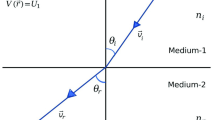Summary
The drift velocity for electrons (or holes) in a scattering medium is obtained as the sum of the usual first-order expression plus a correction term. Both terms are expressed as integrals over a single variable and the integrands are known functions of the electron differential collision frequency. Since the correction term is small compared with the principal, usual term, the expression obtained is in practice equivalent to an explicit rigorous solution.
Резюме
Получается выражение для скорости дрейфа электронов (или дырок) в рассеивающей среде, как член первого порядка плюс поправочный член. Оба члена выражаются через интегралы по одной переменной, причем, подынтеградьные выражения представляют известные функции дифференциальной столкновительной частоты электронов. Так как поправочный член является малым по сравнению с обычным главным членом, то полученное выражение практически эквивалентно точному строгому решению.
Similar content being viewed by others
References
G. Cavalleri, E. Gatti andF. Gonzalez-Gascon:Nuovo Cimento B,55, 291 (1980).
G. Cavalleri andR. Bonalumi:Nuovo Cimento B,55, 318 (1980).
G. Cavalleri andG. Sesta:Phys. Rev.,170, 286 (1968);G. Cavalleri:Phys. Rev. Lett.,23, 907 (1969); for nonisotropic scattering seeS. Paveri-Fontana:Lett. Nuovo Cimento,1, 1259 (1970).
G. Cavalleri andS. Paveri-Fontana:Phys. Rev. A,6, 328 (1972).
See the appendix ofR. W. Crompton, M. T. Elford andA. G. Robertson:Aust. J. Phys.,23, 667 (1970); alsoS. Paveri-Fontana:Aust. J. Phys.,25 329 (1972);R. E. Robson andK. Kumar:Aust. J. Phys.,24, 835 (1971).
See, for example,R. W. Crompton, M. T. Elford andR. L. Jory:Aust. J. Phys.,20, 369 (1967); alsoA. G. Robertson:J. Phys. B,5, 648 (1972).
G. Cavalleri andR. Bonalumi:Nuovo Cimento B,55, 375 (1980).
Notice that the divergences occur forv→0 and that, forv→0, we can always putv=αv n for any functionv=v(v) occurring in practice. Usually the cross-sections σ(v) tend to a nonzero value forv→0 and, therefore,v=Nσv∝v, i.e. n=1. The worst case occurs with neon, where a Ramsauer effect atv=0 gives rise to a collision frequency going to zero, forv→0, asv n withn≤1.7 (see, for example,A. G. Robertson:J. Phys. B,5, 648 (1972); see alsoD. G. Thompson:J. Phys. B,4, 468 (1971)).
G. Cavalleri, R. Di Lascio andV. Giuntoli:Nuovo Cimento B,55, 329 (1980).
G. Cavalleri:Nuovo Cimento B,55, 385 (1980).
Author information
Authors and Affiliations
Additional information
Work supported by ENEL.
Переведено редакцией.
Rights and permissions
About this article
Cite this article
Cavalleri, G. A highly accurate and simple expression of electron drift velocity in gases and semiconductors. Nuov Cim B 55, 360–374 (1980). https://doi.org/10.1007/BF02739166
Received:
Published:
Issue Date:
DOI: https://doi.org/10.1007/BF02739166




